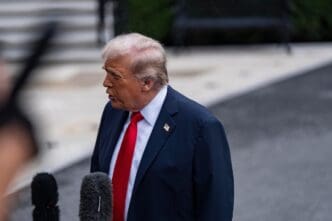Executive Summary
The Story So Far
Why This Matters
Who Thinks What?
The Supreme Court is set to review the legality of tariffs imposed by the Trump administration, fast-tracking an appeal from lower court rulings that deemed many of these levies unlawful. The decision, anticipated soon, will address whether the International Emergency Economic Powers Act (IEEPA) grants the President authority to impose such tariffs, a question with significant implications for both the U.S. economy and the scope of presidential power.
Judicial Review of Tariff Authority
President Donald Trump had levied tariffs of up to 50% on nearly 100 countries, citing the IEEPA as his authority. However, a federal appeals court recently noted that the 1977 law does not explicitly mention “tariffs” or related terms.
The appeals court further emphasized that “the power of the purse (including the power to tax) belongs to Congress.” The Supreme Court’s response to this ruling, which has been stayed until October 14, is expected to be a critical indicator of its stance on executive authority.
According to the source article, a ruling against President Trump would mark the Supreme Court’s first significant effort to restrain him. Conversely, a decision in his favor could be interpreted as the court’s “complete abdication of review authority” and a challenge to the constitutional system of checks and balances.
Administration’s Defense and Legal Standing
The Trump administration’s legal defense is characterized as operating on “very weak” footing, relying on what the source describes as “the Chicken Little Defense.” President Trump has warned that revoking his signature economic policy would lead to “total disaster” for the U.S.
Treasury Secretary Bessent has stated that the government might be compelled to refund up to $1 trillion to importers if the tariffs are overturned. However, the source suggests this argument should not sway the Supreme Court.
Despite the appeals court ruling 7-4 against the White House, the source notes that three judges in the majority believed tariffs are permissible under the IEEPA because it allows the president to “regulate” imports. These judges reportedly opposed only “the arbitrariness and scope of the Trump tariffs,” which the source suggests provides a “slim path to victory” for President Trump at the Supreme Court.
The Major Questions Doctrine
The article points to recent precedent, specifically the Supreme Court’s 2023 decision to strike down President Biden’s student loan forgiveness program. That ruling invoked the major questions doctrine, which stipulates that the executive branch can only exercise powers unambiguously granted by Congress on matters of “vast economic and political significance.”
The source argues that these constraints “clearly apply” to the current tariff dispute. The upcoming decision will reveal whether the justices adhere to these principles or find “yet another escape hatch for Trump,” and whether the major questions doctrine is applied uniformly or “only to constrain Democratic presidents.”
Outlook
The Supreme Court’s impending decision on President Trump’s tariffs represents a pivotal moment for U.S. economic policy and the balance of power between the executive and legislative branches. The ruling will not only determine the fate of significant trade levies but also clarify the extent of presidential authority under emergency powers legislation and the consistent application of judicial doctrines.








